Danspace Project presents Julie McMillan in Benjamin Kimitch’s KO-BU.
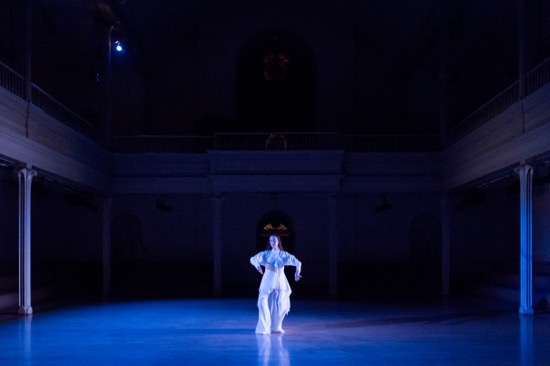
Julie McMillan in St. Mark’s Church as Benjamin Kimitch’s KO-BU begins. Photo: Ian Douglas/courtesy Danspace Project
Waiting for the crosstown bus that will taken me home from St. Mark’s church, I think only about what I have just seen: Danspace Project’s presentation of Benjamin Kimitch’s uncannily beautiful Ko-bu, performed by—embodied by—Julie McMillan, his creative collaborator. A little later, I can link the experience to that of watching the slowly unfolding works by Eiko and Koma or Kazuo Ohno and the pieces by Robert Wilson that I encountered in the late 1960s and early 1970s: from Deafman Glance to The Life and Times of Joseph Stalin. Kimitch’s Ko-bu, like these, requires you to quiet your breathing, sharpen your perception, open your mind. You cannot be wondering what’s next or thinking ahead.
Too, Ko-bu is sparer than any of these—at least visually. McMillan, anchored to the center of the stage, is the eye of a storm that rises and calms around her. That tumult is provided by the Malmö Symphony Orchestra’s recording of “The Housatonic at Stockbridge,” section III of Charles Ives’s Orchestral Set No. 1 (aka Three Places in New England), plus the three sections of the composer’s Orchestral Set No. 3 conducted by Ives scholar James B. Sinclair and edited by either Sinclair or David Gray Porter, with the last section of the latter realized by Nors Josephson from incomplete source material.
The lusty poeticism of Ives’s music can be compared to a storm at sea, in which debris from a shipwreck occasionally floats to the surface. You may think you hear a scrap of “She’ll be Coming Round the Mountain” or “My Old Kentucky Home” swim to the surface, or a piccolo playing Reveille. And then wonder if you were imagining that. The richness of the composer’s textures and the tempests that seethe up occasionally seem to worry at McMillan as she stands alone in the center of the empty nave.
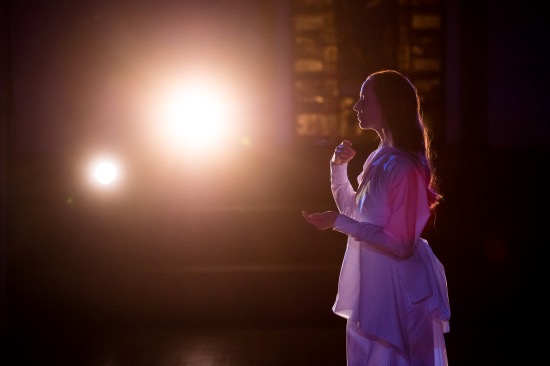
Julie McMillan in Benjamin Kimitch’s KO-BU. Photo: Ian Douglas/courtesy Danspace Project
She’s not there when the music begins. We sit for maybe four minutes listening to Ives in blackness, except for a single glowing stained glass window on the church’s eastern wall. We first see McMillan with the faint rosy glow of Kathy Kaufmann’s lighting behind her. She’s wearing a pristine, elegantly engineered outfit by TOME that vaguely resembles martial arts attire: full white pants, a long-sleeved coat, and a white piece of fabric that crosses her breasts and ties behind her. The music dies, the lights go out.
She is revealed anew by a lavender spotlight. Her right hand, slightly curled, is near her face, and her head is inclined a bit toward it. Her left hand is lower, its fingers also curled, as if she’s holding something. The lights begin to brighten.
After a while, anyone who might have been expecting her to “dance” begins to understand that this will not happen. Instead, McMillan is moving so minimally and so slowly that sometimes it takes a while to see that she is moving at all, yet the smallest adjustment produces a change in how we see her.
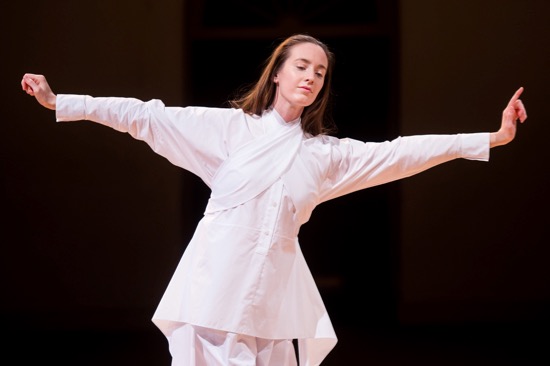
Julie McMillan in Benjamin Kimitch’s KO-BU. Photo: Ian Douglas/courtesy Danspace Project
At first, she seems to be sleeping, but after a few minutes, she’s standing straighter. In time, we realize that her left arm is descending, and her right hand is moving toward the center of her body. I can almost imagine an invisible musical instrument held between them, but that’s my own imagination flaring. When her eyes blink, it’s momentous. For a moment, I think I detect a slight smile. The audience sits intent, rapt.
Before writing this, I followed a link provided in the program and read Christopher Myers’ responses to Ko-bu (http://www.danspaceproject.org/2017/02/23/a-glossary-of-terms/). He cites a study published in the Proceedings of the Second Annual Conference of the Cognitive Science Society, entitled “Viewpoint Dependent Facial Expression Recognition, Japanese Noh Masks and the Human Face.” Photos show a single wooden mask from Noh drama set at positions ranging from tilting down to tilting up, the point being that the Noh actor, by simply changing the angle of his head can convey exaltation, terror, ferocity, anything.
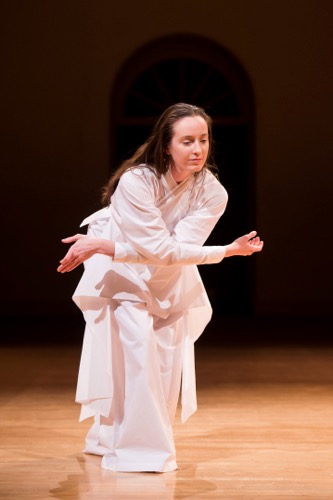
Julie McMillan in Benjamin Kimitch’s KO-BU. Photo: Ian Douglas/courtesy Danspace Project
As I watch McMillan’s smooth, slow, barely noticeable adjustments in her stance, the angle of her arms, the lean of her body, the slant of her head, I see subtle changes in her, despite her prevailing meditative mood. She can seem contented, sober, or privately amused, testing—perhaps, what each change will accomplish. Kimitch gives us ample time to watch her float her arms through a limited range of positions—how they spread apart, bend or straighten. Once, memorably, they cross in front of her as she bends forward more deeply than she has before. Once, you can imagine her listening to an invisible phone in her right hand. You see her bare right foot and wonder if she has moved it; you may note that her knees have bent and wonder if you could be perceiving the beginning of an action that will move her from this spot to which she seems affixed.
These gradual shifts are enhanced by Kaufmann’s lighting. Near the end, lit primarily from her left, McMillan appears spiritually shadowed, and it’s at this point that a small miracle appears: one of her hands, slightly extended, is outlined, then isolated in light, as if she’s holding it in her palm (it’s around this time that deep tones fill the music). And not long afterward, McMillan reminds me of a Madonna I once saw. Does the fact that we are in a church promote that vision?
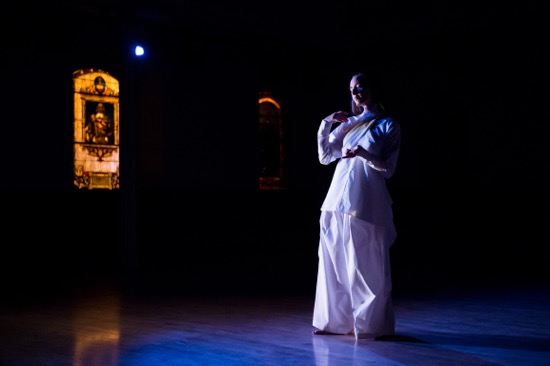
Julie McMillan in Benjamin Kimitch’s KO-BU. Photo: Ian Douglas/courtesy Danspace Project
Ives’ buoyant melodies, sweet calls, distant echoes, and swirling tumult never seem to touch her— or perhaps they induce responses too controlled to be visible. Perhaps we have been seeing a progression and didn’t realize it, because, by the time the lights begin very slowly to dim, McMillan has reached a point of equilibrium that allows her to bend slightly forward and slowly, slowly lift her right foot from the floor. The church turns black before she can take that first, eventful step.
The effort and the concentration that McMillan maintains redefine virtuosity. My thoughts slip around her. I can’t take my eyes off her. I can’t not wonder why, say, the index finger of her left hand is extended and then later seems bent. I link her faint smile to those of the apsaras, the celestial dancers of Hindu and Buddhist mythology. There’s no hurry. I watch.
I don’t read the program note until the next morning. It’s a presentation by a priest in the Twin Cities Buddhist Association of Minneapolis (twelve miles from Kimitch’s birthplace) to Phyllis Ono Kimitch (1949-2001), announcing her Homyo, or Buddhist Name. It is to be Shaku KO-BU. I quote his words: “Shaku = disciple of the Buddha, KO = drum and BU = dance. But together the combination has the meaning of inspiration.”
In KO-BU, Benjamin Kimitch both offers homage and affirms his heritage through art.

Thank you for that poignant, thoughtful response to Ben Kimitch/Julie McMillan’s piece. It’s one I craved to see, but I’m in rehearsals for Michael Weller’s “Loose Ends” at T Schreiber, I’m nursing a hamstrung/knee strain, and I’m absent from the dance scene right now. Thanks for reminding me! I hope they’ll do it again; Ben takes a long time to make work, so I’ll eagerly await the next iteration of “Ko-Bu”.’.